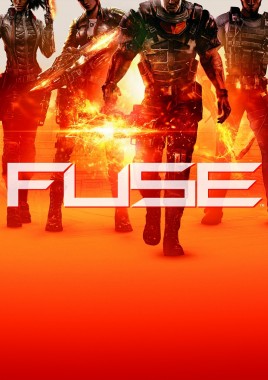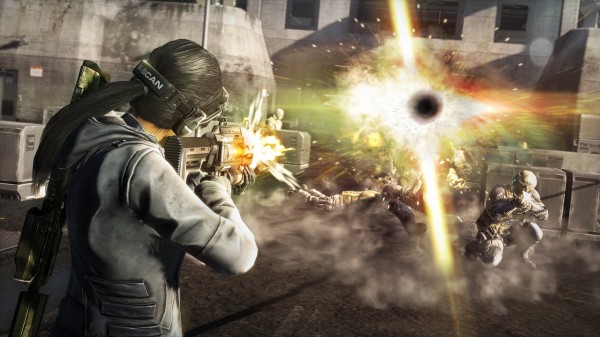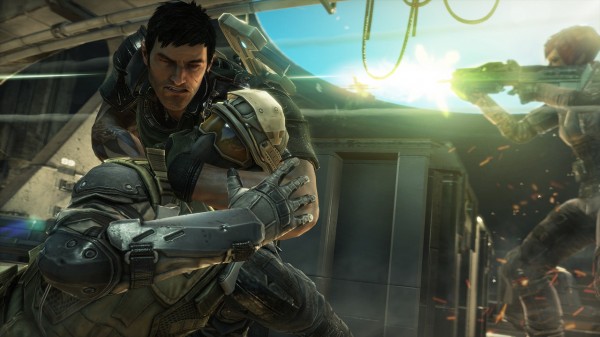
We (Luke and I) recently got substantial hands-on time with Insomniac Games‘ upcoming cooperative action-shooter Fuse, our preview of which can be read here. While at the EA held preview event, we also received the opportunity to interview Insomniac Games CEO and President Ted Price about the game. It was a pleasure to meet him and he gave us some great insight into the title and its development. Without further ado, here it is:
If I remember correctly, you announced the development of a project that would turn out to be Fuse back in May of 2010. It was then first officially revealed in May of 2011 as Overstrike. So what’s that journey been like now 3 years in and mere weeks away from release? Has the process been an arduous one?
Every new IP we create is a journey, it really is. And I mentioned it earlier today, but every new IP brings unexpected challenges with it. And with this IP in particular, the biggest challenge was figuring out how to make the weapons fit together, because we knew it had to be a co-op game; that was our goal from the very beginning. But at the same time, we wanted to make it really fun for single-players as well as 2 players, or 3 players or 4 players, and the key to that was coming up with exotic weapons that were not only exotic on their own but could be combined in combat to be satisfying. And that took us a long time – that was probably the most difficult part of the journey; to figure out how to give the weapons the right punch and keep them balanced. In particular, we didn’t want one weapon to stand out among all the others as the “go-to weapon” for everybody. So that’s why the game continued to change after we showed off the first trailer in 2011. In fact, specifically at that point, even though we had some cool-looking stuff it wasn’t working well in the game – it wasn’t very fun – so we had to go back to the drawing board a few times just to figure out “how can we make this work”. But, we eventually got there and that has been very satisfying.
Actually Brian Allgeier (Fuse Creative Director) mentioned as much to us at the EA Showcase, so it’s good to see you guys cracked that code on balance so to speak. Now, did it being your first multi-platform title bring any challenges?
I wouldn’t…not more than…not unexpected challenges I suppose. We took it as an opportunity to build a new engine and a new tool set which addressed a lot of issues that we’ve had endemically at Insomniac in terms of iteration time. So the new tools have let us spend more time on say iterating with the weapons and balancing the game.
So when the project was re-branded from Overstrike to Fuse, how deep did that change go? Was it more than a title/marketing change?
Well, we realised when we began digging even deeper into the story that the story wasn’t necessarily about the organisation Overstrike – Overstrike is the name of organisation that we reference in the story, but what drives the story is Fuse, the alien element. We realised that relatively late in development and it didn’t make as much sense to continue to focus on Overstrike because we weren’t answering a lot of questions about that organisation. Instead, we were answering more questions about Fuse and integrating Fuse heavily into the gameplay. So we wanted to make a more cohesive universe versus something – a name – that just didn’t apply to the game’s overall focus.
I was going to ask the obligatory “what differentiates Fuse from other shooters”, but we got to personally experience the answer just now. One thing we were surprised with was the little platforming sections – I know that you were interested in that inclusion Luke…
Yeah, I felt the climbing aspects added something to the third-person shooter gameplay archetype. What was the inspiration for those sections? Was it something that you had always planned from the start?

It came as a result of wanting to create highs and lows in the game and not have a one-note game. The temptation is to have big battle after big battle because that is generally fun, but that can be numbing after a while. And so we needed a way to not only break up combat, but to tell more story in the game. And those times where you are climbing around or going stealthy – doing different things in the game – are good chances for us to give players a break from constant combat. In my opinion, that helps enhances the excitement you get from combat situations. I will say too that this is not a traversal or platforming game; these are “traversal-lite” sections.
Like transitional areas…
Yeah, and it was also a chance for us to show off some of the environment too because it’s easy to build battlefields where you’re focused on getting to cover and looking for flanking paths, but when you can offer players a chance to climb around and look at the beautiful scenery, it just helps open the game up a little bit.
And makes the world more immersive…
Yeah; that’s the goal. We hope that the world is a little more solid for people in doing that; that they are immersed and believe that they are in this Insomniac-esque world.
With the unified progression system – and we don’t know what sort of level cap is in place – but was there a lot of work put into how quickly someone can level up? Because, theoretically – and it’s been seen in games before – you could spend a lot of time in multiplayer, level up however much and then come into single-player/campaign much stronger, making it easier. Was that a big consideration?
Yeah, balancing that was another aspect that was challenging about making the game. However, as you’ve experienced, Echelon [the multiplayer mode] is tough! It’s not a cakewalk and we’ve made sure that you can’t just go in and constantly level up and then have fully levelled characters in the campaign, that’s just not going to happen. We spent a lot of time play-testing and making sure that the numbers felt good and that we didn’t allow players to progress so quickly that they’d feel like they conquered the game early. At the same time, we didn’t want to make it brutal. My feeling is a lot of players…usually players start off with the story-driven campaign, but they will want to check out Echelon – they go in and play for a while, and when it gets to hard they jump out, return to the campaign and tart levelling up their characters and eventually go back and try out Echelon again. Because they’re both connected in terms of the progression system, we believe it’s incentive to actually jump around a lot more.

From what we played, it feels very well balanced. We levelled up to Level 10 I believe…
Did you really? Congratulations, that’s awesome!
Yeah, and then after you left for another interview we made it to Wave 9 in Echelon. We got smoked at Wave 4 and thought “is it really gonna be this tough?!”, but we got our act together…and then got slaughtered at Wave 9. [Laughter]. But anyway, one specific question I have relates to those bug-like, explosive enemies – I can’t remember what they’re called…
We call them “seekers”.
Oh, that’s right. I found myself purposely switching from my Xenotech weaponry to my pistol or machine gun because I didn’t want to waste that powerful weapon’s ammo on these things that are weaker and can be destroyed by fewer bullets. Was that something you considered, that they would maybe not force, but influence the player to use their whole arsenal in that strategic sense?
Well, we didn’t want to make any common enemy frustrating and I think that if you have a very small enemy who’s moving fast on the ground but does a lot of damage when he gets close to you – if you make him a bullet sponge, it’s frustrating. Because they’re hard to track also, so we wanted to make them more popcorn-esque. And we’ve had a lot of experience with what we call “swarmers” in other games like Ratchet & Clank or Resistance where we’ve hit that challenge and we have made the mistake of making “swarmers” difficult and it is literally frustrating. The mechanical aspect is that you are used to shooting pretty much straight or up, and when you have to aim down, it’s an additional complication. And so, when you force players to aim down at a quick, small enemy you have to make them easy to kill.
I was wondering about the fact that you acquire the Xenotech weapons almost immediately. Was there a lot of discussion within the team about the option of drip-feeding players those weapons and other new weapons?
Also, when you get captured in the prison on Triton, they’re taken away and we thought “ah, they just gave us a taste”, but then you get them back 15 minutes later…
Well, we wanted to introduce them really early because they are so key to the game and we also wanted to introduce those light co-op elements early without over-burdening you with a fully powered-up weapon. As you know, you unlock skills with those weapons as you move through the game. We certainly experimented with unlocking a lot more early on and we found that players were confused. For example, if we give you the Warp Rifle and unlock the invisibility function early, it’s almost impossible to figure out how to use all of those functions strategically, so we wanted to ease players into it. The fact that we take them away from you in the second level has as much to do with story as it does with gameplay. At the same time, we wanted players to experiment with stealth in that second level on Triton, and without the Fuse weapons you are certainly encouraged more to be stealthy and that was our subtle way of teaching you that “hey, this game can be played in a stealthy fashion” at times instead of going guns-blazing.

I didn’t look too far into the skill/upgrade tree to see how deep the customisation goes for the additional mechanics for the weapons and characters, outside of the trap for Jacob for example…
So that’s a main ability you unlock for his Fuse weapon, but then you also will unlock additional Fuse-related abilities; a couple that are incredibly useful as you move through with each of the four characters. Now, they’re not tied to each of the weapons, they are overall Fuse abilities that are, again, super, super useful and they change up the way you play the game later.
Did you pull anything specific from your work on Ratchet & Clank and other past games in designing Fuse?
You will see the Insomniac DNA here in a lot of areas; first and foremost the weapons – going over the top, coming up with exotic weapons that you don’t see in other shooters…but we have a heavy focus on controls and camera too. We want to make it really easy to do what you want in the game, and an example of that is the way we use cover. If you noticed, we have a very liberal cover system where when you press ‘B’ (on the Xbox 360) you get sucked into cover from a fair way away, and we spent a lot of time with that and had numerous arguments and discussions on how liberal we should be. But, we realised that – like in Ratchet & Clank – it’s gotta feel intuitive when you are, say, doing certain things in the game that are core to the game – in this case it’s taking cover, vaulting cover and climbing. All those things have to feel really natural, so the timing of your button press and the distance at which you can activate these actions was something we really spent a lot of time on.
Would you say that pure “fun” was your first and foremost focus in creating the game? It sounds like a simple question, but there are many games out there that design presentation, story, etc., first…
I mean, that’s a great question; at first we focused on the world and the story as we were building our systems – as I mentioned this is a new engine and tool set – but then we dug in heavily into what makes the weapons satisfying. And it’s a complex equation because it involves, not only the functionality of that weapon, but how enemies react to that weapon; how they die, the audio, the recoil…all of those things that, in many cases, we take for granted are just subtle parts of the equation or ingredients in the final stew and when it comes together, what you get is a weapon that is fun to use and is really satisfying. But figuring out the right measure of each of those ingredients is what takes a long time to get right.
Well that just about covers all of our questions. The game is looking great; we were really impressed with it.
Well thank you very much for spending so much time with it and it was actually fun watching you guys play it!
You can play the Fuse demo as of today. Fuse is coming out in Australia on May 30th for the Xbox 360 and PlayStation 3. Keep it locked on Capsule Computers for our subsequent review in the coming fortnight.

